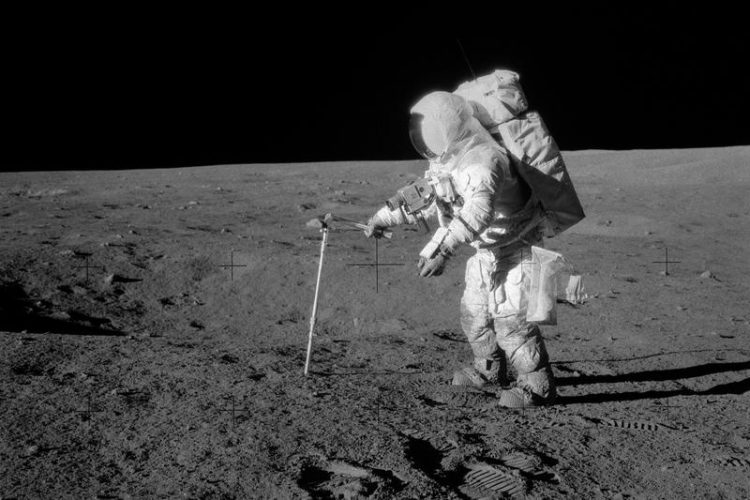Supernova iron found on the moon

Astronaut Alan Bean, lunar module pilot, drives a core sample tube into the lunar surface during the Apollo 12 extravehicular activity. TUM scientists found traces of Supernova iron in such samples. NASA
A dying star ends its life in a cataclysmic explosion, shooting the majority of the star's material, primarily new chemical elements created during the explosion, out into space.
One or more such supernovae appear to have occurred close to our solar system approximately two million years ago. Evidence of the fact has been found on the earth in the form of increased concentrations of the iron isotope 60Fe detected in Pacific ocean deep-sea crusts and in ocean-floor sediment samples.
This evidence is highly compelling: The radioactive 60Fe isotope is created almost exclusively in supernova explosions. And with a half-life of 2.62 million years, relatively short compared to the age of our solar system, any radioactive 60Fe originating from the time of the solar system's birth should have long ago decayed into stable elements and thus should no longer be found on the earth.
Lunar samples from the Apollo missions
This supernova hypothesis was first put forth in 1999 by researchers at the Technical University of Munich (TUM) who had found initial evidence in a deep-sea crust. Now their claim has received further substantiation: Physicists at the TUM and their colleagues from the USA have succeeded in demonstrating an unusually high concentration of 60Fe in lunar ground samples as well.
The samples were gathered between 1969 and 1972 during Apollo lunar missions 12, 15 and 16, which brought the lunar material back to earth.
It's also conceivable that 60Fe can occur on the moon as the result of bombardment with cosmic particles, since these particles do not break up when colliding with air molecules, as is the case with the earth's atmosphere. Instead they directly impact the lunar surface and can thus result in transmutation of elements. “But this can only account for a very small portion of the 60Fe found,” explains Dr. Gunther Korschinek, physicist at TUM and scientist of the Cluster of Excellence Structure and Origin of the Universe.
Deposits of newly produced stellar matter
“We therefore assume that the 60Fe found in both terrestrial and lunar samples has the same source: These deposits are newly created stellar matter, produced in one or more supernovae”, says Dr. Korschinek.
Since the moon generally provides a better cosmic record than the earth, the scientists were also able to specify for the first time an upper limit for the flow of 60Fe that must have reached the moon. Among other things this also makes it possible for the researchers to infer the distance to the supernova event: “The measured 60Fe-flow corresponds to a supernova at a distance of about 300 light years,” says Korschinek. “This value is in good agreement with a recently theoretical estimation published in ‘nature’.”
The lunar samples were investigated using the high-sensitivity accelerator mass spectrometer of the Maier-Leibnitz Laboratory near Munich. In addition to the TUM's physicists, US scientists from Rutgers University and the Planetary Science Institute in Los Alamos were also involved in the publication. Financial support for the research was provided by the German Research Foundation (Deutsche Forschungsgemeinschaft, DFG) via the Excellence Cluster Universe.
Publication
Interstellar 60Fe on the surface of the Moon
L. Fimiani, D. L. Cook, T. Faestermann, J. M. Gomez-Guzman, K. Hain, G. Herzog, K. Knie, G. Korschinek, P. Ludwig, J. Park, R. C. Reedy, and G. Rugel
Phys. Rev. Lett. 116, 151104, April 13, 2016 (online) – DOI: 10.1103/PhysRevLett.116.151104
Contact:
Dr. Gunther Korschinek
Technical University of Munich
James-Franck-Str. 1, 85748 Garching, Germany
Tel.: +49 89 289 14257
E-Mail: korschin@tum.de
Dr. Thomas Faestermann
Technical University of Munich
James-Franck-Str. 1, 85748 Garching, Germany
Tel.: +49 89 289 12438
E-Mail: thomas.faestermann@mytum.de
Press contact:
Petra Riedel
Excellence Cluster Universe
Technical University of Munich
Boltzmannstr. 2
85748 Garching, Germany
Tel.: +49 89 35831 7105
E-Mail: petra.riedel@universe-cluster.de
http://journals.aps.org.eaccess.ub.tum.de/prl/abstract/10.1103/PhysRevLett.116.1…
http://www.gams.ph.tum.de
http://www.tum.de
http://www.universe-cluster.de
Media Contact
All latest news from the category: Physics and Astronomy
This area deals with the fundamental laws and building blocks of nature and how they interact, the properties and the behavior of matter, and research into space and time and their structures.
innovations-report provides in-depth reports and articles on subjects such as astrophysics, laser technologies, nuclear, quantum, particle and solid-state physics, nanotechnologies, planetary research and findings (Mars, Venus) and developments related to the Hubble Telescope.
Newest articles

Pinpointing hydrogen isotopes in titanium hydride nanofilms
Although it is the smallest and lightest atom, hydrogen can have a big impact by infiltrating other materials and affecting their properties, such as superconductivity and metal-insulator-transitions. Now, researchers from…

A new way of entangling light and sound
For a wide variety of emerging quantum technologies, such as secure quantum communications and quantum computing, quantum entanglement is a prerequisite. Scientists at the Max-Planck-Institute for the Science of Light…

Telescope for NASA’s Roman Mission complete, delivered to Goddard
NASA’s Nancy Grace Roman Space Telescope is one giant step closer to unlocking the mysteries of the universe. The mission has now received its final major delivery: the Optical Telescope…



